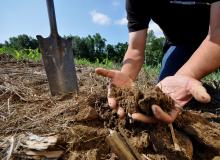
Conservation Technical Assistance (CTA) provides our nation’s farmers, ranchers and forestland owners with the knowledge and tools they need to conserve, maintain and restore the natural resources on their lands and improve the health of their operations for the future.
NRCS offers this assistance at no cost to the producers we serve. Our goal is to give our customers personalized advice and information, based on the latest science and research, to help them make informed decisions.
If a producer chooses to take the next step towards improving their operations, we can work with them to develop a conservation plan, with suggested conservation practices that can help them reach their production and conservation goals.
Producers can also choose to apply for financial assistance to get help installing the conservation practices outlined in their conservation plan.

Conservation Planning
A conservation plan identifies a customer’s conservation objectives and assesses and analyzes the natural resources issues on that customer’s land.
Additional Information
Purpose of CTA
CTA provides land users with one-on-one advice, proven conservation technologies and the delivery system needed to achieve the benefits of a healthy and productive landscape.
How CTA Works
The CTA program works through a voluntary conservation network that fosters partnership between NRCS, conservation districts, state conservation agencies, and millions of private landowners.
CTA Benefits
Helping farmers, ranchers and forestland owners improve the health of their working lands helps protect our natural resources while helping to ensure the longevity of American agriculture.



